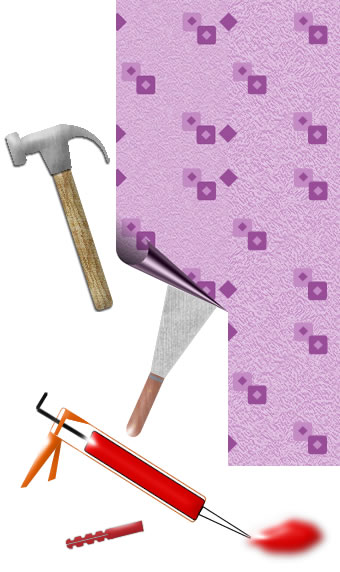Painting, decorating and home improvement tips blog
How to paint new plasterwork
Posted by Adrian
April 7th, 2012
Painting new plaster
When you have had either walls or ceilings plastered or skimmed over with plaster you need to know how to paint them correctly to get a long lasting finish.
Firstly ensure they are dry, this will depend on what plastering you have had done. One thing not to do, start painting colour samples on bare plaster, due to the brushes that come with the samples and how thick you apply the sample you will see this on your walls forever unless you rub them down, best to paint on some lining paper or plain white paper, you can then move it around the room and see the colour in different lights. There is a previous post about this Colour samples and testers.
To Paint new plasterwork
Firstly get some sandpaper, not too course, as you don’t want to ruin the new plaster, around 120 grit and lightly rub over the plaster to remove any splashed plaster or drips of dirty water. Then brush the area down to remove any loose dust.
Next, you may well think it’s simply a case of deciding on a colour and painting over the new plaster? STOP!
You should never paint new plaster with a vinyl emulsion as this will sit on top of the plaster leaving a skin or layer that could peel off. You should always paint new plaster with a ‘New Plaster Sealer’ or a non-vinyl emulsion.
I use a non-vinyl emulsion and is my preferred method. I use a matt emulsion, typically white to seal the plasterwork before using a vinyl emulsion colour over the top to complete the job. The ‘New Plaster Sealer’ or a non-vinyl emulsion will soak into the new plasterwork and the finish coats you apply will adhere to this first ‘mist’ coat.
You don’t have to worry about covering the plaster totally, you just need to give it a ‘mist’ coat (as it’s known) to seal the plaster, you’re not looking for complete coverage and opacity.
Once you have mist coated your new plaster you can now apply your choice of finish coat and colour.
Paint Calculator
You may find my paint calculator useful to help work out the quantity of paint you require to mist coat your new plaster and also for your final finish coat. One thing to note, new plaster can be absorbent so slightly more paint maybe required than normal to get a good depth of colour and a good finish.
Tags: Ceiling, Emulsion, Mist Coat, Paint, Paint Calculator, Plaster, Plasterwork, Vinyl, Walls, water-based paints
Posted in Decorating Tips | 20 Comments »
Decorating and preparation
Posted by Adrian
February 9th, 2010

Decoration or Preparation?
Preparation is key
A good decorating job consists of 90% preparation and 10% decoration, get these percentages around the wrong way, and you’ll know about it.
Taking the time to prepare before you decorate will pay dividends by giving you a far superior finish.
Things such as removing old wallpaper, washing things down, dusting off all take time but need to be done and done right.
For ceiling and walls
Remove any old wallpaper first. Stick back any loose paper if you just want to paint over it.
Make sure any loose plaster is rectified; fill holes and cracks.
Remove any old rawl plugs and fill the holes.
Ensure filler is sanded down properly and not left high, as it will show.
Woodwork
Make sure you rub down woodwork before painting it.
Use a suitable primer on any bare wood, then undercoat it and then topcoat it.
If you topcoat straight over topcoat and not give the surface a key first the topcoat applied will easily chip or scratch off.
General
Let new plaster completely dry out before decorating.
Deal with any damp problems at source rather than just cover it up.
Remove any mould that may of grown and treat the affected area.
Remember, preparation is key. Do it well and it will show in the finished job, do it badly and you will see it forever!
Get a professional in if you are unsure what to do or simply don’t want to take the time to “prep for you dec”.
Tags: Ceiling, Decorating, Decoration, New Plaster, Preparation, Walls, Woodwork
Posted in Decorating Tips | 1 Comment »
